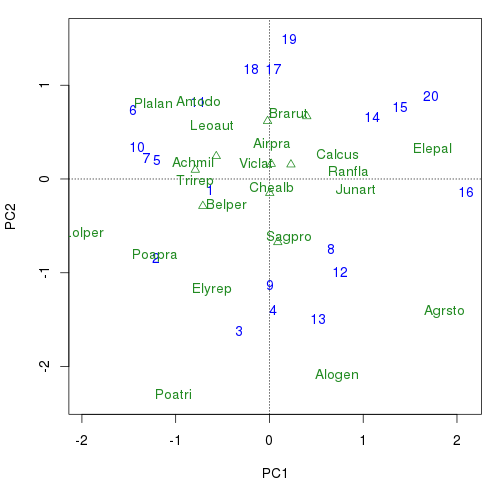
Chapter 2 Data Visualisation 1. In this session we’ll look at data visualisation using the ggplot2 package (Wickham 2009) from the tidyverse (Wickham 2017).As with most R stats courses, we’re focusing on data visualisation early on as this allows you to get a good grasp of your data and any general patterns within those data prior running any inferential tests. A general purpose toolbox for personality, psychometric theory and experimental psychology. Functions are primarily for multivariate analysis and scale construction using factor analysis, principal component analysis, cluster analysis and reliability analysis, although others provide basic descriptive statistics. In R there are several ways to do exploratory factor and principal components analysis. Best reference, and developer of the ‘psych’ package: William Revelle, see links inside R in documentation on the ‘psych’ package. Ch 6 of his forthcoming book is highly recommended. Also very good, Michael Friendly’s page, not specific to R. This is one of a set of How To'to do various things using R (R Core Team,2019), particularly using the psych (Revelle,2020) package. The current list of How To’s includes: 1.Installing R and some useful packages 2.Using R and the psych package to nd omega h and w t. 3.Using R and the psych forfactor analysisand principal components analysis.
R Biplot Psychiatrist
| plot.psych {psych} | R Documentation |
Plotting functions for the psych package of class “psych'
Description
Combines several plotting functions into one for objects of class “psych'. This can be used to plot the results of fa, irt.fa, VSS, ICLUST, omega, factor.pa, or principal.
Usage
Arguments
x | The object to plot |
labels | Variable labels |
xlab | Label for the x axis – defaults to Latent Trait |
ylab | Label for the y axis |
ylim | Specify the limits for the y axis |
main | Main title for graph |
type | 'ICC' plots items, 'IIC' plots item information, 'test' plots test information, defaults to IIC. |
D | The discrimination parameter |
cut | Only plot item responses with discrimiantion greater than cut |
keys | Used in plotting irt results from irt.fa. |
y2lab | ylab for test reliability, defaults to 'reliability' |
qq | if TRUE, plot qq plot of residuals, otherwise plot a cor.plot of residuals |
... | other calls to plot |
Details
Passes the appropriate values to plot. For plotting the results of irt.fa, there are three options: type = 'IIC' (default) will plot the item characteristic respone function. type = 'IIC' will plot the item information function, and type= 'test' will plot the test information function.

Note that plotting an irt result will call either plot.irt or plot.poly depending upon the type of data that were used in the original irt.fa call.
These are calls to the generic plot function that are intercepted for objects of type 'psych'. More precise plotting control is available in the separate plot functions. plot may be used for psych objects returned from fa, irt.fa, ICLUST, omega, as well as principal
A 'jiggle' parameter is available in the fa.plot function (called from plot.psych when the type is a factor or cluster. If jiggle=TRUE, then the points are jittered slightly (controlled by amount) before plotting. This option is useful when plotting items with identical factor loadings (e.g., when comparing hypothetical models).
Objects from irt.fa are plotted according to 'type' (Item informations, item characteristics, or test information). In addition, plots for selected items may be done if using the keys matrix. Plots of irt information return three invisible objects, a summary of information for each item at levels of the trait, the average area under the curve (the average information) for each item as well as where the item is most informative.
How To Read Biplot
If plotting multiple factor solutions in plot.poly, then main can be a vector of names, one for each factor. The default is to give main + the factor number.
It is also possible to create irt like plots based upon just a scoring key and item difficulties, or from a factor analysis and item difficulties. These are not true IRT type analyses, in that the parameters are not estimated from the data, but are rather indications of item location and discrimination for arbitrary sets of items. To do this, find irt.stats.like and then plot the results.
Value
Graphic output for factor analysis, cluster analysis and item response analysis.
Note
More precise plotting control is available in the separate plot functions.
Author(s)
William Revelle
See Also
VSS.plot and fa.plot, cluster.plot, fa, irt.fa, VSS, ICLUST, omega, or principal
Examples
R Biplot Psychology
Part of the Personality Project Take our Personality Test